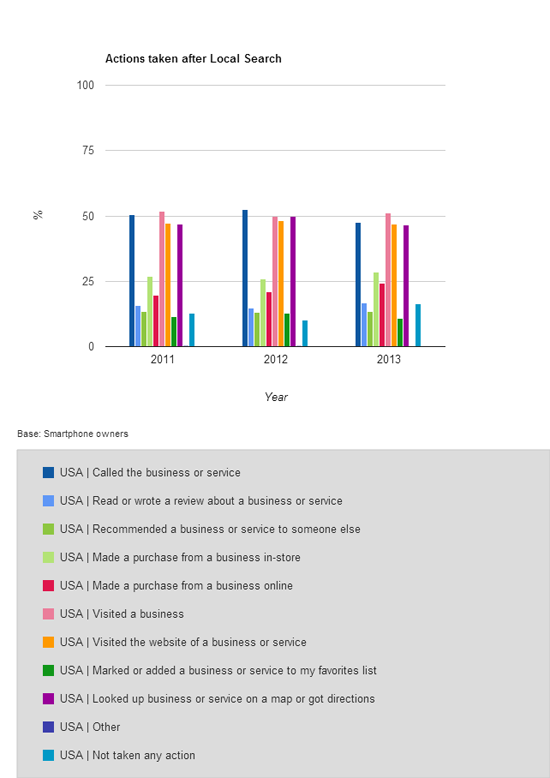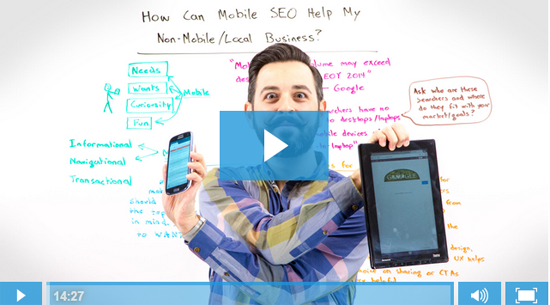Mobile SEO Best Practices in 2014

Anyone working in the online community should be well aware of the growing bias toward browsing and buying from mobile devices. If you as marketers, Web professionals or business owners fail to adapt to the changing consumer, your company may be in trouble, especially if you are relying on search traffic. Currently the search volume is still higher on desktops but Google has said they believe that the number of mobile searches will exceed the number of desktop searches by the end of 2014.
The Facts about Mobile
Here are a few important statistics compiled by leading research company Nielsen in their 2013 and 2014 mobile consumer reports.
- In 2012, mobile traffic grew 70 percent reaching numbers comparable to all users with Internet connectivity in 2000
- Between 2012 and the time of the survey (mid-2013), the average time spent per month browsing phone apps and mobile Internet increased an average of 35 hours per person.
- In this same time frame, the average time spent on a desktop browser per person per month has decreased by about two hours.
- Smartphone owners spend 86 percent of their time on mobile apps and only 14 percent on mobile browsers.
- Hispanic consumers use 16 percent more data than the national average, Hispanics make up 15 percent of the U.S. population and that number is growing.
Without reading the entire report, you can clearly see that mobile is going to become even more important in the coming years and the Hispanic market is leading the charge. If you have been putting off mobile marketing, the time to stop is now.
Marketing Your Website to the Mobile Consumer
Mobile apps account for 86 percent of the time spent on mobile phones. I am sure that Flappy Bird and the several knock-offs of that game account for a good portion of that time, but shopping and researching accounts for the majority of the time spent on apps. Combine this with apps that let you find local businesses or services and you have a lot of interested consumers that can be reached via mobile apps. The best part, you don't have to create an app to benefit from one.
Let's look at the restaurant space as an example. There are a ton of applications that help consumers find local restaurants such as Urban Spoon and Zagat. But how do these apps find and return results? The bad news is, each application uses their own methods so the exact methods needed to improve if or how you appear on an app very greatly. The good news is that if you optimize your site properly, you will get picked up by many apps automatically.
If you have a business that could produce a useful application for your target market, you could be reaching a lot more customers. Like a website, applications need to be optimized to appear higher in the list, this is known as ASO. How to optimize your application depends on where it is listed. Google and Apple are both big players in the market. Google considers inbound links to applications and Apple does not, aside from that, here are some of the ranking factors for both stores.
- Reviews
- Downloads
- Keyword rich title
- Keywords used in descriptions
- Proper category selection
- Images/screenshots/logos- increases likelihood of download
According to Zain Shah, you can improve your rankings in the Google Play Store by also leveraging Google +1s and YouTube.
In addition to Google and Apple, there are several other app stores that are very popular. These include Amazon, Crackberry (Blackberry exclusive app store) and Appolicious (this one is associated with Yahoo so it is probably worthless).
For those of you who cannot develop an app or do not want to, let's take a look at the best practices for mobile SEO in 2014.
Mobile-Friendly Web Design
It seems like a no brainer, especially to a Web professional; unfortunately that's not the case for everyone. A couple of studies conducted in 2013 looked at the percentage of fortune 500 companies that had mobile-optimized websites and while the numbers varied by source, the range was between 6 percent (per Search Engine Watch) up to 20 percent (per Career Builder). This means in the best case scenario, only 1 in 5 fortune 500 companies are mobile ready and if they aren't doing it, chances are many smaller companies are not either. There are numerous ways to create a website that is mobile friendly depending upon your budget.
Getting Mobile Ready on a Small Business Budget
If you are a small company with little to spend, setting up a responsive site using a CMS like WordPress is a good option. If you know how to set up the site yourself, you are only out the cost of a responsive template plus images and text. If you need someone to install and set up your theme, this can start as low as $750 on average but the cost will obviously increase with the more customizations you make.
Build a Stellar Customized Mobile Site
If you are a larger company or you have the budget for a better website, you can either have a mobile specific site built or you can have a customized responsive layout designed. There is a lot of debate about responsive vs. mobile but either one is better than serving users the mobile nightmare that you call a website. Building custom sites is much more time consuming so you should expect to pay anywhere from $5-$30K + (based on information collected from about 20 Web design companies) depending upon the requirements of your website.
Regardless of budget, you need to find a way to make sure your site meets Google's guidelines on building smartphone optimized websites. On page SEO best practices apply to mobile sites and once you have included those elements you should also:
Test Your Mobile Site Speed- This can be done using Google's Page Speed Insights Tools or Mobitest. Both are free to use and can offer some valuable insight into issues with your site. Mobitest also allows you to see how your site performs based on various mobile devices.
Make Sure Embedded Videos are Responsive- This is a common mistake people make, especially novice DIY website designers. If you are using a responsive website theme and you include a video in an Iframe (YouTube and Vimeo Embed in Iframes) it will not be responsive. In order to solve this issue all you have to do is wrap the video in tags and use CSS to style it or you can use JavaScript to do the job. Here is a good tutorial on it that I tested and it works.
Check Responsiveness of Add On Formatting- Let's say you decide to use CSS to make a three-column layout on your website. There are several ways to do this but not all of them are responsive. Test your pages and if columns or other modifications made are not responsive, you need to revise your code.
Consider Size Differences on Mobile Devices- Sometimes your website may look perfect on a tablet but is barely readable on a smartphone. When creating your site, make sure to consider that smallest common screen size in use today and make sure your site can function at that size. Some common mistakes are to use font sizes and buttons that are too small.
If you include the basic on-page elements and you double check the four common mistakes above, you are off to a good start. Local searches make up the majority of searches done from mobile devices and they result in a high conversion rate as well. Here is some data collected by Google and Our Mobile Planet about local mobile searches and the corresponding actions.

Local Mobile SEO - Same Old Stuff, Different Way
If the numbers above did not make it clear, I will. You need to optimize your mobile website for local searches. If you have a physical location anywhere, you are a local business to someone. If you service areas that are nationwide and you have only one location, you can still reach local searchers.
A while back Google mentioned that you should have a unique page for every location your business has. This was in response to people using one page for several locations or buying a domain for each location of a business. Currently, you can use a landing page targeting a certain city or state. As with any SEO, you need to optimize the page for your keyword, including original content, and do your best to make it relevant to the city/state targeting. The only difference is that you will build links to the page instead of citations since you do not have an address in the city/state.
Alternately, if you have a physical address in every location you service, you should still set up a page for each city. When building citations, use the URL of the landing page for the city you are working on, not the homepage. You should also avoid putting multiple locations on a single page.
The bottom line: If you have a fast and mobile-friendly website running a standard local SEO campaign is going to help you rank higher and generate more traffic.
The key differences between a desktop SEO campaign and a mobile campaign are:
- Searches use different keywords and search phrases are shorter on average so you should look for unique mobile keywords.
- Google has stated they prefer responsive design over mobile sites, so using responsive can be beneficial to your mobile SEO but is does not have any effect on the rankings of standard sites.
- If you have a dedicated mobile site, using less website content is OK in many cases because it improves user experience. Dedicated mobile sites should also use Canonicalization to help Google better understand and crawl the pages. This is also referred to as using switch tags. Here is how they recommend setting up your mobile and desktop page.

Non-Localized Mobile SEO
As with anything in SEO, not everyone agrees about the percentage of people using mobile devices. In a recent Whiteboard Friday, Rand Fishkin discussed the number of mobile users who view Moz and shared some good tips on mobile SEO. If you don't have time to watch the video, some key takeaways are:
- Review your target audience and see how likely mobile searchers are to visit your site.
- Use Google Analytics to find out which pages on your site are getting the most mobile visitors.
- Google will reduce traffic to sites that are not mobile friendly.
- Make sure informational pages are mobile optimized since they are the leading pages visited by most mobile searchers.
- Avoid forcing an application download as it decreases the user experience.
- Limit choices on mobile devices improves user experience and conversions.
Video of Whiteboard Friday
Adding to what Rand had to say, I believe that social shares are going to have an impact on mobile searches before, or more noticeably, than on desktop searches. This is because of the push to customize local mobile searches by Google and several popular applications. Combine that with the interlinking of numerous social profiles on mobile devices and it points to the benefits of leveraging social signals to provide a better experience. The real question is; when will personalized search no longer be optional?
Either way, you need to make sure your site is mobile ready and optimized if you want to continue seeing search traffic in coming years.
From the Readers-Mobile SEO, SEO and Online Marketing as a Whole
Last week I wrote an article discussing the influence of social media on SEO. Robert B. brought up a very interesting point in his comment and I wanted to share that with you. To paraphrase, Robert stated that even though social media may not directly influence search rankings it is a powerful tool for connecting with potential customers and getting them to your website. He went on to say the general ideology of SEO is to bring traffic to a website by any plausible means and for that reason, social signals could be considered a direct part of SEO. Furthermore, even if participating in social does not influence Google's SERPs, it does impact how you appear within the internal search of Twitter, Facebook and other sites. All of these efforts combined bring more traffic to your site, increase your exposure and potential to earn natural links, and ultimately allow you to turn contacts into customers.
This comment really resounded with me because as an SEO it is easy to get a one-track mind, to focus on a single goal and toss everything else by the wayside. Today we talked about ASO and Mobile SEO. These methods should be combined with content marketing, social media participation, pay per click advertising and outreach on sites your customers are likely to visit.
As my mother told me many times as a child "don't put all your eggs in one basket" and this is true for online marketing as well. I like to think of websites and SEO as a financial investment. Will you take a high-risk, high-reward approach, will you be extremely conservative to reduce risks at the cost of lower returns or will you combine the two?










